 | |
| Monastery information | |
|---|---|
| Order | Premonstratensian |
| Established | 1150 |
| Disestablished | bet. 1581 and 1600 |
| Mother house | Alnwick Abbey |
| Diocese | Diocese of St. Andrews |
| People | |
| Founder(s) | Hugh de Morville |
| Important associated figures | Adam of Dryburgh, Andrew Forman |
Dryburgh Abbey, near Dryburgh on the banks of the River Tweed in the Scottish Borders, was nominally founded on 10 November (Martinmas) 1150 in an agreement between Hugh de Morville, Constable of Scotland, and the Premonstratensian canons regular from Alnwick Abbey in Northumberland.[1] The arrival of the canons along with their first abbot, Roger, took place on 13 December 1152.[2]
It was burned by English troops in 1322, after which it was restored only to be again burned by Richard II in 1385, but it flourished in the fifteenth century. It was finally destroyed in 1544, briefly to survive until the Scottish Reformation, when it was given to the Earl of Mar by James VI of Scotland. It is now a designated scheduled monument[3] and the surrounding landscape is included in the Inventory of Gardens and Designed Landscapes in Scotland.[4]
David Erskine, 11th Earl of Buchan bought the land in 1786. Sir Walter Scott and Douglas Haig are buried in its grounds. Their respective tomb and headstone, along with other memorials, are collectively designated a Category A listed building.[5]
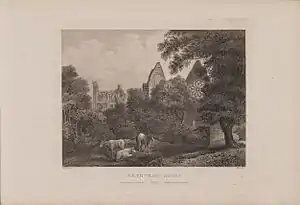
The Premonstratensian order
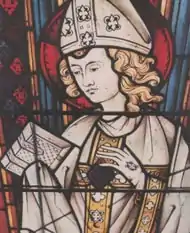
The Premonstratensian order was founded by St Norbert of Xanten who was firstly a canon at Xanten Cathedral. Unhappy with the way of life of his fellow canons, he left the Rhine lands for the diocese of Laon, in the north of France where the reforming Bishop Bartholomew was transforming his see into one that was more apostolic.[6] Bartholomew persuaded Norbert to form a canonical order at Prémontré, in Aisne in 1120 and while the order was Augustinian in form, the canons wore the white habit and not the black.[7] They followed an austere monastic life but had a duty to preach and teach to those on the outside of the monastery walls.[7] The order spread rapidly across Europe with the Abbot of Prémontré becoming Abbot-General for all the daughter-houses.[7] Even before the first Abbot-General Hugh of Fosse died, one hundred and twenty abbots attended the annual general chapter.[8] The Premonstratensians took on many of the methods of the Cistercians including land management and the use of lay-brothers to undertake the labour-intensive work of the communes.[9]
Abbey endowments
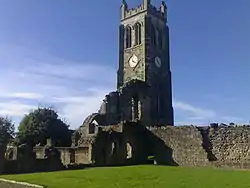
Unlike the situation at nearby Melrose Abbey with its royal patronage, Hugh de Morville, although a very wealthy noble, could not endow Dryburgh on the same scale as that of a monarch.[10] However, it seems that King David I of Scotland was not unsympathetic to the monastery; it is recorded in a charter that as well as confirming various donations from de Morville's wife, Beatrice de Beauchamp, the king allowed the abbey to take freely, timber from his forests for the building work.[11] Hugh gave the lands of Dryburgh containing the forests, grasslands and accompanying waters; the fishings from Berwick; the churches with their lands at Mertoun and Channelkirk in his lordship of Lauderdale and Asby in Westmoreland; and the earnings from the mills of Saltoun and Lauder.[12] Beatrice gave the income from the church at Bozeat, Northamptonshire to the abbey[13] as well as lands at Roxburgh that she bought solely for the purpose of subsequent donation.[14]
Hugh, in around 1162, like some other magnates of the period, turned his back on worldly affairs and entered the abbey-church, adopting the habit of the canons.[15] He gave his elder son, Richard, his large Scottish estates while his younger son, Hugh, received those in England.[16] Hugh, the senior, died at Dryburgh Abbey that same year.[17]
Following Hugh's death, his son Richard carried on as patron to the abbey. However, in c. 1170 he founded the hospital of St Leonard near his castle at Lauder[18][19] and then sometime between 1169 and 1187, the abbey of Kilwinning in the lordship of Cunningham.[20] Although Kilwinning Abbey was built on a grand scale, it was inadequately provided for[21] and so Richard ensured that some of the expense of its construction and upkeep was met from his holdings in Lauderdale; indeed a long-running argument broke out between Kilwinning and Dryburgh over the former's share of the tithes from the church of Lauder.[22] Richard de Morville's establishment of this second monastery ensured that both establishments would remain in a state of relative poverty.[23]
Daughter houses
Dryburgh Abbey, despite this underfunding, managed to attract a continuous flow of novices to bolster the numbers of canons, so much so that by the closing years of the 12th century the abbey was overcrowded necessitating the establishment of colonies.[24] John de Courcy, the earl of Ulster installed a colony at Carrickfergus and a second at Drumcross[25] but neither flourished in the longer term and this is put down more to the constant political convulsions throughout 13th century Ulster rather than any problems at the motherhouse.[24]
Mounting debt

At the beginning of the 13th century, like its near neighbour Melrose Abbey, the abbey of Dryburgh commenced on a rebuilding programme on a grander scale, but building in stone against a background of an insecure income soon ensured that the construction work would not be completed quickly.[26] Also at this time, the monastery became embroiled in a series of legal proceedings regarding land ownership and tithe revenues resulting, in April 1221, in the Pope's legate having to spend some time at Dryburgh to adjudicate.[27] The construction effort was protracted and endured into the 1240s and with debts continuing to mount to the point that David de Bernham, Bishop of St Andrews gave Abbott John permission on 21 April 1242 to appoint his canons as vicars to the supporting churches stating[28]
… since they have been burdened by grinding debts both on account of construction of the monastery and also on account of other and various necessities.
Pope Innocent IV granted to the abbey in 1246, on the anniversary of its consecration, an indulgence lasting forty days intended to attract visitors who would hopefully be generous with their alms-giving.[29] Additionally, he also provided a suspension of the requirements to create pensions and benefices that might deplete the abbey's revenues, and importantly, safeguarded the monastery, its property and the canons themselves against legal redress.[30]
Abbott John was blamed for ineffectual financial management and was required to resign and, on 13 January 1255 Pope Alexander IV wrote to the Bishop of St Andrews (position vacant at the time) and to Nicholas de Prenderlathe, abbot of Jedburgh demanding that most of the abbey's income be diverted to paying off debts while only a basic level of income was to be retained for day to day expenses.[31] Slow improvement in the abbey's finances took place over the next forty or so years in a period of relative stability. However this improvement was only relative; Dryburgh's neighbouring monasteries with their much more extensive grazing lands provided the main source of a much greater income.[32]
Changing patronage
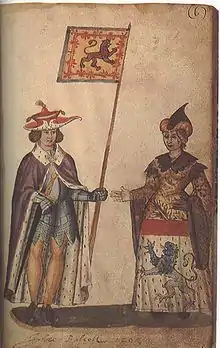
Hugh de Morville's line had died out in 1196 on the death of his grandson, William, and the estates passed to William's sister, Helen, whose husband was Lochlann, Lord of Galloway. The semi-independent Lords of Galloway were much wealthier than the de Morvilles but even they could not lavish large amounts on all their dependencies.[33] Lochlann was already benefactor to four religious houses in Galloway that included his own Cistercian establishment of Glenluce Abbey as well as being associated with Holyrood Abbey in Edinburgh and the Cumbrian abbey of Holmcultram and the priory of St Bees.[34] Dryburgh being one of many establishments who sought the generosity of the Galloway lords got a further setback in 1234 when Alan, the last of the line of Galloway lords, died. His property was to be split between three daughters and their husbands. The lands previously held by the de Morvilles were divided again and in the 1250s were held by Helen of Galloway with her husband, Roger de Quincy, the Earl of Winchester, and Dervorguilla of Galloway with her husband, John I de Balliol, Lord of Barnard Castle and Gainford.[34] These new owners in Lauderdale diluted the available patronage yet again as they themselves had pre-existing commitments however the de Quincys did provide a fishing in Mertoun Loch, a burgage at Haddington and lands at Gledswood near Bemerside.[35] Devorguilla's main concern however was her own foundation at Sweetheart Abbey,[36] but she was at Dryburgh in 1281 to settle her lands in England on her son, John Balliol, the future king.[37] Balliol came to the throne of Scotland on St Andrews Day, 1292[38] but his reign was short and he abdicated in July 1296 following the defeats of the Scots at Berwick and Dunbar at the hands of King Edward I of England.[39] This heralded the end of a long period of stability in the borderlands.
Wars of Scottish Independence
The abbots of Dryburgh, Jedburgh, Melrose and Kelso all submitted to Edward I on 28 August 1296 at an event later to be described as the Ragman Rolls,[40] and so on 2 September, Edward ordered that lands belonging to the abbey of Dryburgh be restored.[41] From this point up to the year 1316, very few records of the abbey exist, however it is known that Sir Henry de Percy, one of the senior members of the English occupying force, placed himself and his cortege at Dryburgh in 1310.[42] Despite the abbey's affiliation with the Balliol family who remained resolutely at odds with the Bruce monarchy, the abbot and canons, before 21 October 1316, expelled two of their rank for refusing to acknowledge Robert as their king; a grateful King Edward II of England rewarded them by providing them with the rent and fishery of the abbey at Berwick.[43]

Evidence is lacking on Robert's participation as a patron of Dryburgh. He certainly used the abbey as a base in July 1316 while conducting raiding expeditions into Northumberland.[44] In retaliation for Bruce's raids in July 1322, Edward II of England took his army north in August only getting as far as Edinburgh. The English army retreated through Lauderdale and looted and burned both the abbeys of Melrose and Dryburgh.[45] Melrose Abbey's reconstruction was generously provided for by Robert[46] while Dryburgh's needs seem to have been ignored.[47] It is unclear why Bruce chose to be so ungenerous towards the canons of Dryburgh; Melrose was granted £2000 by Robert while Dryburgh received the confirmation of a pre-existing rent of 20 shillings per annum[47][48]
Walter Stewart, 6th High Steward of Scotland and Bruce's son-in-law was not unsympathetic to the abbey though and transferred to it his entitlements from Maxton church, and its lands and provided 4 acres (16,000 m2) of land belonging to himself.[49] In 1326, Bishop John de Lindsay of Glasgow endorsed the abbey's possession of the church and allowed the canons to use its considerable income to help fund the rebuilding process.[50] Bruce's brother-in-law, Sir Andrew Murray a Guardian of Scotland during the exile of King David II may also have given holdings in his Smailholm lands[51] Added to these were gifts from lesser donors; people like Patrick de Dunbar, earl of Marsh who gave a handful of possessions while Sir William Abernethy gave lands in Saltoun and various other minor nobles added further packets of land.[52] Robert the Bruce died in June 1329 and in August 1332 Edward Balliol, son of the ousted King John, returned to Scotland with an army provided by the disinherited Scottish landowners and defeated the Scottish army at the Battle of Dupplin Moor, near Perth and had himself crowned King of Scots at Scone.[53] In December, Balliol was attacked at his castle at Annan in Galloway by John Randolph, 3rd Earl of Moray and Sir Archibald Douglas and was forced to flee into England.[53] With the support of King Edward III of England, Balliol was restored to the Scottish crown but at the price of having to make Edward his overlord and ceding to him the sheriffdoms of Berwick, Dumfries, Edinburgh, Peebles and Selkirk, including the forests of Ettrick and Jedburgh[54] Dryburgh found itself once again under English domination. However, this did not adversely affect the abbey; Sir Wiliam de Felton, the new Sheriff of Roxburgh and Keeper of Roxburgh Castle, bought and granted to the abbey a significant burgage in Roxburgh.[55]

In 1334, Balliol was forced to Berwick for protection and the English were slowly finding their authority in the Lothians slipping away and only managed to hold power in the garrisoned centres and so in mid-July 1335, Edward III marched his army to Glasgow where he met with Balliol and his army and together they advanced to Perth.[56] In October, following his campaign, Edward moved to Dryburgh Abbey where he expected the Scots to present him with their terms of surrender but this did not happen.[57][58] David II returned from France in 1342 and more of the lands held by Edward III were won back into Scottish control so that by 1346, the county of Roxburgh and the western parts of the county of Berwick were in the charge of the Bruce party.[59] Patronage for the canons was once again provided by Scottish lords when it is recorded that Sir John Maxwell gave the income from the Pencaitland church, in East Lothian.[60] The Scottish lordship changed again when David was captured at the Battle of Neville's Cross and an English garrison took command at Roxburgh putting the central lands of Tweeddale and all of Teviotdale firmly back under the control of England and it was to remain so for over twenty years.[61] On 20 January 1356 Abbot Andrew of Dryburgh along with the Abbots of Melrose, Jedburgh and Kelso witnessed Edward Balliols resignation.[62] With the English victory over the French in September 1356, Scotland lost its continental ally and forced her back to the negotiating table for the release of David II from hostage. The treaty for the Scottish king's release was agreed on 3 October 1357 and four days later David was back in Scotland; under the terms of the treaty, 100,000 marks were to be paid to England over 10 years and England would retain its occupied lands until the ransom was paid in full.[63]
Borderland partition
David II's liberation from hostage in 1357 did not come without conditions, one of which was that Edward would hold on to the lands in the southeast of the country; this ensured that Dryburgh and the other border abbeys stayed in English held territory. David allowed the abbeys to keep their Scottish possessions and did not interfere with the canons and monks from receiving the income from those.[64] Dryburgh's records had all been lost at this time and it is only from what is known at Melrose that Dryburgh's position can be traced. The wool export trade and the resultant customs duty was important to David and so the Border abbeys who produced large amounts of wool were encouraged to use the Scottish ports and at the expense of Edward's Berwick.[62] The 1360s and 1370s saw the English hold over the Border areas diminish until it was basically the castles at Berwick, Jedburgh and Roxburgh with the county of Berwick and the eastern part of the county of Roxburgh still in their grip. Pressure on these bastions intensified during 1384 and 1385 and Scottish raiding parties moved deep into England forcing Richard II to launch his army on a hugely damaging incursion through the Borders to Edinburgh which he burned.[65] On the way he ordered the sacking of Dryburgh, Melrose and Newbattle.[66] It was while Richard was in Newbattle Wood in August 1385 that he took reprisals against all those in Teviotdale who had returned to the Scottish cause.[67]
Turning point
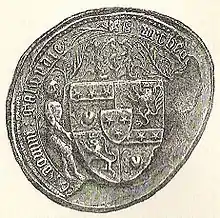
The damage caused to Dryburgh was great and influential nobles seemed to have played a significant part in its restoration—in the closing years of the 1380s it seems that Robert Stewart, Earl of Fife, Archibald Douglas, 3rd Earl of Douglas and Walter Trail, Bishop of St Andrews all had roles in assisting the abbey to extricate itself from this disaster.[68] King Robert III, in a charter dated 9 March 1391, granted to the canons all the very substantial income-rich possessions of the Cistercian nuns of South Berwick which had been destroyed by Richard II in 1385.[69] The family of the Black Douglases continued with their support[70] and in around 1420 Archibald, fourth earl of Douglas gave Dryburgh the income from the possessions of Smailholme parish church.[71] The fifth earl continued the grant of Smailholm and went further in 1429 by asking the pope to formally confirm this together with the inclusion of the hospitals of St Leonards of Lauder and Smailholme.[72] In 1443, the canons suffered once again when fire destroyed the abbey, evidently by accident[73] yet eighteen years later in 1461, the abbey is recorded as requesting protection from Pope Pius II inferring that the canons were finding it difficult to finance the repairs.[74]
The final century
The abbey lost the patronage of Robert Stewart, Duke of Albany on his death in 1420, and in 1455 with the forfeiture of the lands of the Black Douglases, they lost a major benefactor and protector in James Douglas, 9th Earl of Douglas.[74] The election of Walter Dewer as abbot in 1461 was seemingly the last prelate to be elected by the canons,[75] but it was under his abbacy that alienation of the monastery lands began.[76] The rest of the 15th century was characterised by contests for the abbacy from either indigenous canons and from outside, expulsions, papal refusals or royal intervention.[77]
Commendators
King James IV rewarded clerics who gave him good service by providing them with commendatorships. The first commendator of Dryburgh Abbey was Andrew Forman, the Bishop of Moray in 1509.[78] Forman’s primary role was in the service of James IV as a diplomat and was employed by the king extensively in Europe but accumulated much wealth from his religious and other appointments.
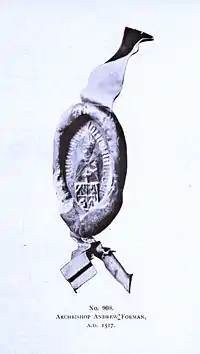
He received the commendatorships of the abbey of Culross in 1492 although he stepped down the following year after being provided with a large pension from the abbey.[79] In June 1497 he was prior of Pittenweem, received the rectory of Cottingham from King Henry VII of England in May 1501, was commendator of Kelso (although he was unable to firmly establish his provision), as well as the Keeper of Darnaway Castle, Chamberlain of Moray and Custumar North of the Spey in 1511.[80]
Forman gave up his rights to Dryburgh sometime after becoming Archbishop of St Andrews and was succeeded by James Ogilvie, another secular cleric and diplomat[78] who received the temporalities of the abbey in August 1516.[81] He held the commendatorship for only a short time, dying in 1518.
David Hamilton, Bishop of Argyll, and the younger brother of James, Lord Hamilton, Earl of Arran, was the next to be proposed to the Abbey by John Stewart, Duke of Albany[81] and became commendator in May 1519. He died in 1523.
The next to be provided to the abbey was James Stewart, a canon from Glasgow cathedral. Although named in a letter from Albany to Cardinal Accolti, Cardinal Protector for Scotland in Rome, Albany actually gave the commendatorship to the Earl of Lennox[82] who in turn sold or gave his right to it to Stewart who then borrowed from money lenders in Paris to purchase the confirming papal bulls. Stewart received the temporalities of the abbey on 6 October 1526 until his death 1539.
Pope Paul III received King James V’s recommendation of Thomas Erskine as the next commendator in November 1539 but was not confirmed until April 1541 due to a contesting provision. In 1541, hostilities between Scotland and England resumed but Dryburgh remained untouched until 7 November 1544 when Edward Seymour, earl of Hertford, burned the town of Dryburgh and its abbey.[83] He returned in 1545 and again set fire to the abbey.[84] Erskine was captured at Dover when the Scottish warship he was aboard foundered while en route to France[85] prompting Marie de Guise, widow of James V, to call for his release.[86] Erskine was ransomed for £500 and Dryburgh would have been expected to provide amply to the settlement and it may have been the need to obtain funds that, in July 1548, he resigned his commendatorship to his brother John.[87]
Like most of his commendatory forebears, John Erskine took very little interest in the spiritual side of the abbey but was an important personage in the politics of Scotland during the reigns of James V, Mary, Queen of Scots, and James VI.[88] John was commendator until 1556 when he stepped down in favour of his nephew, David Erskine.

David Erskine received the bulls confirming his office in July 1556[89] and set about quickly alienating the possessions of the abbey by granting lands to important local families. Erskine took part in the kidnapping of James VI known as the Raid of Ruthven[90] but when the king escaped from his imprisonment in Ruthven castle, he and his accomplices fled to England. Erskine was deprived of his lands and the commendatorship of Dryburgh Abbey was given to William Stewart.[91][92]
William Stewart held the commendatorship for just over a year when in 1585 David Erskine found favour once more with James VI and all of his possessions and appellations were reinstated.[89][93]
In June 1600, Erskine wrote to a relative saying that all the canons had now died[94] and marked the ending of the monastery. In 1604, the remaining possessions of the abbey were integrated into the Lordship of Cardross of John Erskine, the then Earl of Mar.[95] Henry Erskine, Mar’s son received the titular title of commendator of Dryburgh Abbey.[89]
Routine of the canons
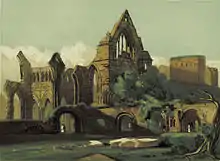
The daily routine of the canons was made up of religious services, agricultural duties, household functions, copying books and reading. In detail, this would have been:[96]
- The canonical hour of Matins was held in the early morning when the canons were wakened by the dormitory bell. They would proceed to the church for the first service of the day following which they returned to bed.
- The Prime service was held at 6 a.m. when the canons were re-awakened and summoned to church for mass; they would remain in private prayers until the bell announcing the daily meeting in the chapter house.
- The community would assemble in the cloister then proceed to the chapter house where a lesson from the rules of the order was read. Any transgressors were held to account for their actions and any punishments carried out by the prior.
- In winter, at the hour of Tierce, or 9 a.m., following on from the meeting of the chapter, the canons would proceed in pairs to the church for the singing of hymns. In summer, there was a longer interval before Tierce so that the abbey duties could be performed. The summer Tierce was a high mass.
- High mass was performed at the hour of Sext, or mid-day, in winter.
- The community ate at 1 p.m. where only two dishes were served except on certain occasions when an additional sweet dish, called a pittance was provided. If someone was late for the meal then unless he had an adequate excuse, he would have to sit at the most remote of the tables and perhaps with no wine or ale.
- After the dinner, some canons rested while others conversed until the hour of Nones, or 3 p.m. when the canons proceeded to church for another service after which, the community were required to wash their hands and wait in the cloister until summoned to the refectory to drink.
- At 6 p.m. the canons attended Vespers.
- The Compline, the last of the day's worship was held after 7 p.m. followed by a light supper and then bed.
- There were no sheets on the dormitory beds and the canons were required to sleep in their habit
- in the Autumn, the agricultural canons would leave for the fields early in the morning and occasionally would not return until after vespers. They had to recite their prayers at the appointed hours as they toiled, however.
List of abbots
- Abbots
|
- Commendators
|
Fat Lips
There is a legend that the ruins of Dryburgh Abbey is the home of a benevolent spirit called Fat Lips. A woman who lost her lover in the 1745 Jacobite Rebellion made her home in the ruined abbey and claimed that Fat Lips, a little man in iron boots, used to tidy her cell for her.[97]
Tourism
This Abbey is part of five other abbeys and historic sights through Scotland on Borders Abbeys Way walk.
Gallery
 Dryburgh Abbey
Dryburgh Abbey Entrance of Dryburgh Abbey Chapterhouse
Entrance of Dryburgh Abbey Chapterhouse Interior of Dryburgh Abbey Chapterhouse
Interior of Dryburgh Abbey Chapterhouse Doorway of the Chapterhouse
Doorway of the Chapterhouse Dryburgh Abbey Calefactory (Warming House)
Dryburgh Abbey Calefactory (Warming House) North Transept Chapel
North Transept Chapel View from Novice's Day Room
View from Novice's Day Room
See also
Notes
- ↑ Chron. Melrose, s.a. 1150
- ↑ Chron. Melrose, s.a. 1152
- ↑ Historic Environment Scotland. "Dryburgh Abbey (SM90103)". Retrieved 27 February 2019.
- ↑ Historic Environment Scotland. "DRYBURGH ABBEY (GDL00145)". Retrieved 27 February 2019.
- ↑ Historic Environment Scotland. "Tomb of Sir Walter Scott, King James obelisk, headstone of Field Marshall Earl Haig and memorials in burial ground to the north of Dryburgh Abbey and excluding scheduled monument SM90103, Dryburgh (Category A Listed Building) (LB15114)". Retrieved 27 February 2019.
- ↑ Fawcett & Oram, Dryburgh Abbey, p. 9
- 1 2 3 Fawcett & Oram, Dryburgh Abbey, p. 10
- ↑ Premonstratensian Canons, The Catholic Encyclopedia, Volume XII, 1911, New York
- ↑ Fawcett & Oram, Dryburgh Abbey, p. 11
- ↑ Fawcett & Oram, Dryburgh Abbey, p. 13
- ↑ Dryburgh Liber, no. 147
- ↑ Dryburgh Liber, nos. 239, 240, 241, 249 and RRS, i, no. 172 and RRS, ii, no.165
- ↑ Stringer, 'Early Lords', p. 45
- ↑ Dryburgh Liber, no. 143 – 145, 147
- ↑ Dryburgh Liber, no. 8
- ↑ Fawcett & Oram, Dryburgh Abbey, p. 14
- ↑ Chron. Melrose, s.a. 1162; RRS, i, 34-5
- ↑ Easson, Religious Houses, p. 149
- ↑ Dryburgh Liber, app. no. 1
- ↑ Watt & Shead, Heads of Religious Houses, p. 127
- ↑ Cowan, Crossraguel and Kilwinning, 268 – 270
- ↑ Dryburgh Liber, nos. 84 – 87
- ↑ Fawcett & Oram, Dryburgh Abbey, pp. 14 – 15
- 1 2 Fawcett & Oram, Dryburgh Abbey, p. 15
- ↑ Macneil, Anglo-Norman Ulster, p. 14
- ↑ Fawcett & Oram, Dryburgh Abbey, P. 16
- ↑ Ferguson, Papal Representatives, pp. 86 -87; Dryburgh Liber, nos. 23, 26, 27, 35, 36, 101, 234
- ↑ Dryburgh Liber, no.38
- ↑ Dryburgh Liber, no. 256
- ↑ Dryburgh Liber, nos. 260 and 264
- ↑ Bliss, W.H., ed. Calendar of Entries in the Papal Registers relating to Great Britain and Ireland : Papal Letters, 1893, London, i, p. 309.
- ↑ Fawcett & Oram, Dryburgh Abbey, p. 18
- ↑ For an understanding of the patronage of the Lords of Galloway, see McDonald, Andrew, Scoto-Norse Kings and the Reformed Religious Orders: Patterns of Monastic Patronage in Twelfth-Century Galloway and Argyll, in: Albion 27, 1995; Brooke, Wild Men and Holy Places, 88–90, 104–106, 124–126, 140–149.
- 1 2 Fawcett & Oram, Dryburgh Abbey, p. 19
- ↑ Dryburgh Liber, nos. 138–141
- ↑ Oram, Lordship of Galloway, pp. 148, 149
- ↑ CDS, ii, no. 189
- ↑ Scottish Kings, p. 115
- ↑ Scottish Kings, p. 116
- ↑ CDS, ii, no. 817
- ↑ Fawcett & Oram, Dryburgh Abbey, p. 20
- ↑ CDS, iii, no. 163
- ↑ CDS, iii, no. 509
- ↑ RRS,v, no. 100
- ↑ Bower, Scotichronicon, vii, pp. 11–13
- ↑ Melrose Abbey, pp. 38–39
- 1 2 Fawcett & Oram, Dryburgh Abbey, p. 22
- ↑ Melrose Abbey, p. 39
- ↑ Dryburgh Liber, no.296
- ↑ Dryburgh Liber, no. 297
- ↑ Dryburgh Liber, No 299
- ↑ Dryburgh Liber, nos. 300–304, 308–312
- 1 2 Bruce Webster, ‘Balliol, Edward (b. in or after 1281, d. 1364)’, Oxford Dictionary of National Biography, Oxford University Press, 2004 accessed 6 September 2007
- ↑ Fawcett & Oram, Dryburgh Abbey, p. 23
- ↑ Dryburgh Liber, nos. 313–316
- ↑ W. M. Ormrod, ‘Edward III (1312–1377)’, Oxford Dictionary of National Biography, Oxford University Press, September 2004; online edn, May 2006 accessed 7 September 2007
- ↑ CDS,iii, no. 1185
- ↑ Nicholson, Later Middle Ages, pp. 131,132
- ↑ Fawcett & Oram, Dryburgh Abbey, p. 24
- ↑ Dryburgh Liber, appendix, docs. iii–v
- ↑ Fawcett & Oram, Dryburgh Abbey, pp. 24, 25
- 1 2 Fawcett & Oram, Dryburgh Abbey, p. 25
- ↑ Boardman, The Early Stewart Kings, p. 10
- ↑ Mel. Liber, ii, no. 433
- ↑ Fawcett & Oram, Dryburgh Abbey, p. 26
- ↑ Bower, Scotichronicon, vii, p. 407
- ↑ Boardman, Early Stewart Kings, p. 138
- ↑ Fawcett & Oram, Dryburgh Abbey, p. 27
- ↑ RMS, i, no. 832. Significantly, Fife, Douglas and Trail all witness the charter
- ↑ Brown, Black Douglases, pp. 185–187
- ↑ CSSR, 1418–22, no. 197
- ↑ CSSR, 1428–32, pp. 66–68
- ↑ Bower, Scotichronicon, vii, p. 175
- 1 2 Fawcett & Oram, Dryburgh Abbey, p. 29
- ↑ Watt & Shead, Heads of Religious Houses, p. 60
- ↑ Dryburgh Liber, appendix, doc. Xiii
- ↑ Watt & Shead, Heads of Religious Houses, pp. 60,61
- 1 2 Watt & Shead, Heads of Religious Houses, p. 61
- ↑ Watt & Shead, Heads of Religious Houses, p. 52
- ↑ C. A. McGladdery, ‘Forman, Andrew (c.1465–1521)’, Oxford Dictionary of National Biography, Oxford University Press, 2004 accessed 12 September 2007
- 1 2 RRS, i, no. 2796
- ↑ CSPS, no. 16
- ↑ Fawcett & Oram, Dryburgh Abbey, p. 35
- ↑ CSPS, i, no. 56
- ↑ CSPS, i, 9
- ↑ CSPS, i, no. 15
- ↑ Fawcett & Oram, Dryburgh Abbey, pp. 35,36
- ↑ Fawcett & Oram, Dryburgh Abbey, p. 36
- 1 2 3 Watt & Shead, Heads of Religious Houses, p. 62
- ↑ Dryburgh Liber, appendix, xxvii
- ↑ APS, iii, pp. 335, 381
- ↑ RMS, v, no. 723
- ↑ RMS,v, No. 723
- ↑ Dryburgh Liber, appendix, no. xxxiii
- ↑ APS, iv, 343–348
- ↑ Morton, Monastic Annals, pp. 292–293
- ↑ Rose, Carol (1996). Spirits, fairies, gnomes, and goblins. ABC-CLIO. pp. 113. ISBN 0-87436-811-1.
ISBN 0-87436-811-1.
Bibliography
- Anderson, A.O. et al., ed. Chronicle of Melrose, London, 1936. [Chron. Melrose]
- Bain, J., ed., Calendar of Documents Relating to Scotland, Edinburgh, 1881-8. [CDS]
- Bannatyne Club, Liber Sancte Marie de Dryburgh, Edinburgh, 1847 [Dryburgh Liber]
- Bannatyne Club, Liber Sancte Marie de Melros, Edinburgh, 1837 [Mel. Liber]
- Barrow, G.W.S., ed.Regesta Regum Scotorum, ed. Edinburgh, 1971. ISBN 0-85224-142-9 [RRS]
- Brooke, D., Wildmen and Holy Places, Edinburgh, 1994. [Brooke, Wild Men and Holy Places]
- Brown, M., The Black Douglases, East Linton, 1998. [Brown, Black Douglases]
- Boardman, Stephen I., The Early Stewart Kings: Robert II and Robert III, 1371 to 1406, Edinburgh, Reprint 2007. [Boardman, Early Stewart Kings]
- Cowan, I.B., Ayrshire Abbeys: Crossraguel and Kilwinning, Ayrshire Archaeological and Natural History Society, 1986. [Cowan, Crossraguel and Kilwinning]
- Cowan, I.B. & Dunlop, A.I., eds. Calendar of Scottish Supplications to Rome, 1428–32, Scottish History Society, 1970 [CSSR, 1428–33]
- Dunbar, Sir Archibald H.,Bt., Scottish Kings – A Revised Chronology of Scottish History 1005–1625, Edinburgh, 1899. [Scottish Kings]
- Duncan, A.A.M, ed., Regesta Regum Scotorum,v, the Acts of Robert I, Edinburgh, 1988. [RRS, v]
- Fawcett, Richard & Oram, Richard, Dryburgh Abbey, Stroud, Gloustershire, 2005. ISBN 0-7524-3439-X [Fawcett & Oram, Dryburgh Abbey]
- Fawcett, Richard & Oram, Richard, Melrose Abbey, Stroud, Gloustershire, 2004. ISBN 0-7524-2867-5 [Fawcett & Oram, Melrose Abbey]
- Ferguson, P.C., Medieval Papal Representatives in Scotland: Legates, Nuncios, and Judge Delegates, 1125–1286, Stair Society, 1997. [Ferguson, Papal Representatives]
- Lindsay, E.R. & Cameron, A.I., eds. Calendar of Scottish Supplications to Rome, 1418–22, Scottish History Society, 1934 [CSSR, 1418–22]
- Morton, James, The Monastic Annals of Teviotdale, Edinburgh, 1837 [Morton, Monastic Annals]
- Nicholson, R., Scotland: the Later Middle Ages, London, 1979. [Nicholson, Later Middle Ages]
- Stringer, K.J., ed. The Early Lords of Lauderdale, Dryburgh Abbey and St Andrews Priory at Northhampton in "Essays on the Nobility of Medieval Scotland", Edinburgh, 1985. [Stringer, Early Lords]
- Thorpe, M.J., ed. Calendar of State Papers Relating to Scotland, i, 1509–1589, London, 1858. [CSPS]
- Thomson, T. & Innes, C., eds. Acts of the Parliaments of Scotland, Edinburgh, 1814–75. [APS]
- Watt, D.E.R and Shead, N.F., The Heads of Religious Houses in Scotland from Twelfth to Sixteenth Centuries, Scottish Record Society, 2001. [Watt & Shead, Heads of Religious Houses]
- Watt, D.E.R., ed., Walter Bower, Scotichronicon, 9 vols., Aberdeen & Edinburgh, 1987–97. [Bower, Scotichronicon]
External links
- Historic Environment Scotland: Visitor guide
- Dryburgh Abbey Photo Page Archived 4 January 2010 at the Wayback Machine
- A dozen images of Dryburgh Abbey
- Engraving of a view of Dryburgh Abbey by James Fittler in the digitised copy of Scotia Depicta, or the antiquities, castles, public buildings, noblemen and gentlemen's seats, cities, towns and picturesque scenery of Scotland, 1804 at National Library of Scotland
- Engraving of Dryburgh Abbey in 1693 by John Slezer at National Library of Scotland